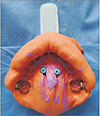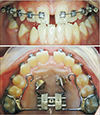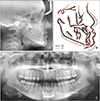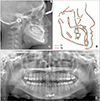Abstract
Figures and Tables
Figure 1
Pretreatment extra- and intra-oral photographs of a young girl with severe Class III malocclusion due to maxillary hypoplasia.

Figure 2
Pretreatment lateral cephalogram, panoramic radiograph, and cone-beam computed tomography images for a young girl with severe Class III malocclusion due to maxillary hypoplasia.

Figure 3
Silicone impression for the fabrication of a hybrid hyrax appliance for alternate rapid maxillary expansions and constrictions in a young girl with severe Class III malocclusion due to maxillary hypoplasia.

Figure 4
A fabricated hybrid hyrax appliance for alternate rapid maxillary expansions and constrictions in a young girl with severe Class III malocclusion due to maxillary hypoplasia.

Figure 5
Intraoral photographs after an 8-week alternate rapid maxillary expansions and constrictions protocol with simultaneous orthodontic treatment in a young girl with severe Class III malocclusion due to maxillary hypoplasia.

Figure 6
Fixation of mandibular miniplates after an 8-week alternate rapid maxillary expansions and constrictions protocol with simultaneous orthodontic treatment in a young girl with severe Class III malocclusion due to maxillary hypoplasia.

Figure 7
Fixation of intermaxillary elastics extending from the mandibular miniplates to the hybrid hyrax appliance and from the mandibular to the maxillary brackets in a young girl with severe Class III malocclusion due to maxillary hypoplasia.

Figure 8
Final intra- and extra-oral photographs after 20-month treatment involving alternate rapid maxillary expansions and constrictions with a hybrid hyrax-mandibular miniplate combination and simultaneous orthodontic treatment for a young girl with severe Class III malocclusion due to maxillary hypoplasia.

Figure 9
Final radiographs after a 20-month treatment period involving alternate rapid maxillary expansions and constrictions with a hybrid hyrax-mandibular miniplate combination and simultaneous orthodontic treatment for a young girl with severe Class III malocclusion due to maxillary hypoplasia. A, Lateral cephalogram; B, superimposition of pre- (T0) and post-treatment (T1) lateral cephalograms; C, panoramic radiograph.

Figure 10
Extra- and intra-oral photographs obtained after 24 months of retention following treatment involving alternate rapid maxillary expansions and constrictions with a hybrid hyrax-mandibular miniplate combination and simultaneous orthodontic treatment for a young girl with severe Class III malocclusion due to maxillary hypoplasia.

Figure 11
Radiographs obtained after 24 months of retention following treatment involving alternate rapid maxillary expansions and constrictions with a hybrid hyrax-mandibular miniplate combination and simultaneous orthodontic treatment for a young girl with severe Class III malocclusion due to maxillary hypoplasia. A, Lateral cephalogram; B, superimposition of post-treatment (T1) and post-retention (T2) lateral cephalograms; C, panoramic radiograph.

Table 1
Measurements from lateral cephalograms acquired before treatment (T0), after a 20-month treatment period (T1), and after a 24-month retention period (T2) for a young girl with severe Class III malocclusion due to maxillary hypoplasia

The patient underwent alternate rapid maxillary expansions and constrictions with a hybrid hyrax-mandibular miniplate combination and simultaneous orthodontic treatment for 20 months, followed by the retention phase.
T0, Taken at the initial visit (11 years old); T1, taken after 20 months of treatment (12 years 10 months); T2, taken after 24 months in retention (14 years 10 months); SNA, sella-nasion-A point; SNB, sella-nasion-B point; ANB, A point-nasion-B point; CoA, Condileon to A point; CoPog, condileon to pogonion; FH, Frankfort plane; Lower anterior facial height, anterior nasal spine to menton; Wits, distance between perpendiculars from A point and B point onto the occlusal plane; U1-PP, maxillary lateral incisor to Palatal plane angle; L1-MP, mandibular incisor to mandibular plane angle.
Notes
How to cite this article Martínez-Smit R, Aristizabal JF, Filho VAP. Correction of Class III malocclusion with alternate rapid maxillary expansions and constrictions using a hybrid hyrax-mandibular miniplate combination and simultaneous orthodontic treatment: A case report. Korean J Orthod 2019;49:338–346.




 PDF
PDF ePub
ePub Citation
Citation Print
Print


 XML Download
XML Download